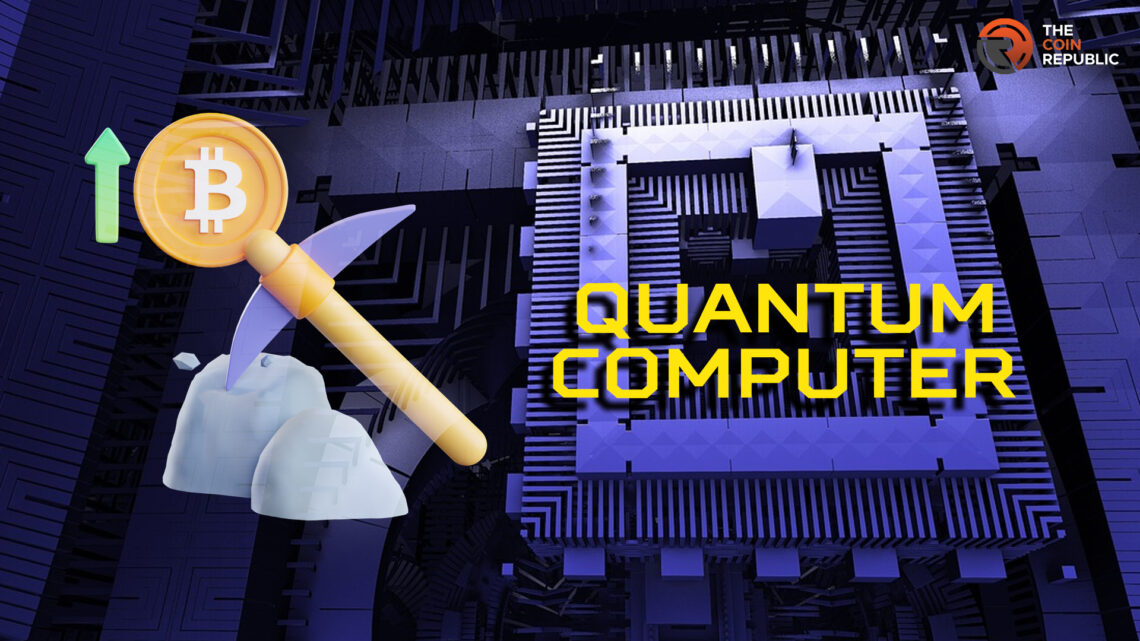- 1 Quantum computers are an emerging tech advancement that could soon find its application in Bitcoin mining.
- 2 These computers are highly advanced, way ahead of all classical computers, and can make blockchains more efficient.
- 3 They can also threaten the core of many cryptocurrencies, while experts debate how real those perceived threats are.
Bitcoin mining and the mining of other cryptos could be on the verge of breaking technological pathways with the hot emerging technology of quantum computing. Quantum computers have many advancements that can very efficiently counterfeit the algorithms of traditional ASIC-based mining software.
Miners worry about the grave threat it poses to decentralization and the security of existing accounts. While experts argue quantum computers are yet to reach there, it must not be forgotten that the technology could also benefit blockchains. Nevertheless, programmers have developed ways to protect against quantum algorithms as well.
Quantum Computers for Mining Crypto
Quantum computers are the most advanced technological intervention of our times that have the potential to unlock ways for humanity to attain progress in areas it has previously stalled.
At the broadest level, these computers can be said to operate in the quantum realm, the most minute microcosm known to date. They leverage the quantum properties of elementary particles such as superposition and entanglement to process computer bits.
Bits are the smallest unit of data used by classical computers. They can have only one of the two values: 0 and 1. But quantum computers use quantum bits or qubits, which can have more than one value simultaneously.
A qubit can be 0, 1, or a quantum superposition of 0 and 1. This makes them capable of processing multiple computations at the same time, thereby, drastically increasing the speed, as compared to classical computers.
Contemporary cryptographic techniques rely on factoring huge numbers, performing logarithmic calculations, and solving equations with up to a million variables. Quantum computers can perform these calculations exponentially faster and, hence, highly potent for attacking encrypted data.
Bitcoin mining is known to be the ultimate driving force behind many aspects of the network be it ownership, funds, transaction speed, or environmental footprint. Bitcoin mining and other Proof-of-Work consensus blockchains use complex mathematical problems to validate transactions and generate blocks.
When users use quantum computing to mine Bitcoin, this gives a lot of power to the entity owning that system.
Quantum Tech for Making Crypto More Efficient
As blockchains become more advanced, privacy-enhancing features, algorithms, and encryptions such as Zero Knowledge Proofs, all of these techniques are adding to the complexity of program codes. Thus, quantum computers can be used to handle these operations more quickly.
Enhanced security is another advantage. Encryptions using quantum algorithms are way harder than the ones normal computers are able to handle. Only the attackers who own quantum computers will be able to hack them.
Many scientists, including crypto enthusiasts, have expressed concerns over the emerging over-private protectionism of blockchain ecosystems like Stellar and MobileCoin.
They are taking encryption to the level of creating a complete blind trail of transactions between two parties almost impossible to trace. This opens avenues for crime funding and money laundering for malicious social elements.
Authorities can use quantum computers to track corruption, in which case they might be the only weapons against breaching the walls of those networks. In all these cases, it is crucial to understand that accessing, holding, and using a quantum computer is not easy.
Currently, they can only be accessed by certain scientific institutions that are only working to invent the technology further.
Even if they emerge in the market, they will be extremely costly, way more than the already hyper-expensive mining hardware such as ASICs. It would be almost non-feasible for an individual person to own the system. Along with that, using the computer and exploiting all its utilities would require no less than a connoisseur.
But one area that is unarguable that quantum computers will solve is the energy consumption of PoW blockchains. Besides being super-fast, these systems use a process called quantum annealing which optimizes every validation by finding the global minimum function. It significantly increases the speed of hash generation and may reduce the infamous power burden of Bitcoin.
Threats to the Existing Blockchains
Bitcoin mining is basically a race of miners, where the first one to solve the rehashing algorithm gets to add the block and earn a mining reward. Quantum computers take advantage of quantum parallelism to solve these problems way quicker by performing simultaneous calculations.
Besides, they can also work on specialized algorithms to win the race which classical computers are not capable of. For example, a quantum algorithm– Shor’s Algorithm can factor large integers at exponentially higher speeds than all the other algorithms.
This mathematical function of factoring large integers is basic to many operations of hash generation and public key encryptions in Bitcoin and other PoW blockchains.
Hence, one of the obvious concerns is the domination of quantum computer owners in the mining race. This will lead to the centralization of the cryptocurrency by a single party owning the remaining BTC and mining rewards.
However, a greater threat quantum technology poses to Bitcoin and other crypto is the security and privacy of accounts and crypto wallets. This is because these systems are more than capable of breaching a very strong set of encryption security protocols used in a cryptographic technique called the Elliptic Curve Digital Signature Algorithm (ECDSA).
Notably, it is used in a vast majority of leading cryptocurrencies, including Bitcoin, Ethereum, Ripple, Cardano, Stellar, Polkadot, and many more.
ECDSA is a cryptographic mechanism for producing public and private key encryptions that are mathematically linked to each other. These keys are required to send and receive crypto assets and store them in a crypto wallet. They are linked directly to addresses of the accounts where transactions occur.
Generation of public and private keys uses an asymmetric cryptographic method, linked together by a mathematical equation. Security in this type of method comes from the fact that the link between public and private keys is a one-way function.
This means the public key can be derived by someone if they know the private key to that address. But, a private key cannot be derived from a public key.
For all classical algorithms to derive the private key from a public key would take an impossible amount of time, thereby, impractical to be done. But quantum algorithms can perform this computation in a day or two.
The public key is freely broadcasted to the entire network, every time that address makes a transaction. Hence, someone using a quantum algorithm can catch hold of one’s private key very easily which gives them complete control of all the funds and transactions of that address.
How Real Are These Concerns?
It is noteworthy that quantum computers are not some magical “can-do-all” machines. When it comes to cryptocurrencies which use some of the highest levels of cryptographic techniques known to man, there are still many limitations to these machines. Besides being subject to ownership due to their sheer cost, the technology itself is very much in its infancy.
Experts have even suggested it might take as long as until 2028 for quantum computers to become advanced enough to outperform traditional technologies such as ASICs for mining, neglecting the possible concurrent advancements in the ASICs technology itself.
This means that it gives some real-time to classical algorithms and ASICs to develop and stand against quantum supercomputers. Many of these techniques, referred to as post-quantum cryptographic methods, already exist and can be made ready for adoption quite soon.
The Lamport Signature is one such method that can secure digital signatures against potential quantum attacks. This technique generates several one-time-use public-private key pairs using a hash function. This technique is developed in alignment with the ECDSA technique.
Bitcoin uses pay-to-public-key-hash (p2pkh) addresses for the transaction recipient, in order to avoid broadcasting the address’ public key on the network, a loophole that can be exploited by a quantum computer. But these addresses are only secure until they initiate a transaction as a sender.
Once they transfer the funds to someone, the public key is revealed. To overcome this problem, it is advised the user should not use that address again. Many wallets are embedded with a feature to avoid address reuse.
The Lamport Signature solves the problem of address reuse by generating one-time-use public-private key pairs that can be used for digital signatures instead of actual public keys.
These key pairs are generated by using a highly secure algorithm that is hard to crack, even if someone has access to the public key and tries to derive the private key in real time.
In terms of encryption, blockchain developers have the upper hand as they can scale the number of digits in cryptographic keys faster than the attackers can develop algorithms to hack them.
These algorithms are defined in Advanced Encryption Standards (AES), established by the US National Institute of Standards and Technology (NIST) in 2001.
The current system of AES-128 features 128 characters in a key and is easily hackable for quantum computers. But AES-256, which features 256 characters, makes it significantly harder for the current quantum machines to hack in a brute force attack.
Besides, the current hashing algorithm, which is used by Bitcoin and many other cryptos, SHA-256 (Secure Hash Algorithm), developed by the US National Security Agency in 2001, is considered to be quantum-resistant. The US NIST also released SHA-3 in 2015, which is considered to be one of the most secure quantum-resistant algorithms.
Interestingly, classical computers outperform quantum computers when it comes to unorganized data. When one needs to locate a record by sifting through a huge random unorganized data, classical computers are more efficient than quantum computers.
It is this weakness the Lattice-Based Cryptography technique exploits, as a post-quantum cryptographic method. It creates “mathematical noise” to confuse quantum processors to decrypt keys by creating an enormous amount of erroneous digital signatures on top of real ones.
Today’s quantum computers are quite far behind in out-scale algorithms like Shor’s Algorithm to attack Bitcoin. According to research by the University of Sussex, it would take a quantum computer with 1.9 Billion qubits to hack a Bitcoin transaction by breaking ECDSA in 10 minutes.
Whereas, IBM’s quantum processor Eagle, considered the world’s currently most powerful quantum computer, contains only 127 qubits. However, the company is set to launch a system of 1000 qubits by the end of 2023. This indicates quantum computers could show exponential growth and soon catch up to the current encryption algorithms. Quantum Bitcoin mining could be a reality in the near future.
Experts have many opinions on this development, leading to the conclusion that it is going to sit at the crossroads of improvement and destruction. It’s a double-edged sword, and the fact— who wields it— is going to be the determining function for the ultimate road that will be trailed.

Adarsh Singh is a true connoisseur of Defi and Blockchain technologies, who left his job at a “Big 4” multinational finance firm to pursue crypto and NFT trading full-time. He has a strong background in finance, with MBA from a prestigious B-school. He delves deep into these innovative fields, unraveling their intricacies. Uncovering hidden gems, be it coins, tokens or NFTs, is his expertise. NFTs drive deep interest for him, and his creative analysis of NFTs opens up engaging narratives. He strives to bring decentralized digital assets accessible to the masses.


 Home
Home News
News






